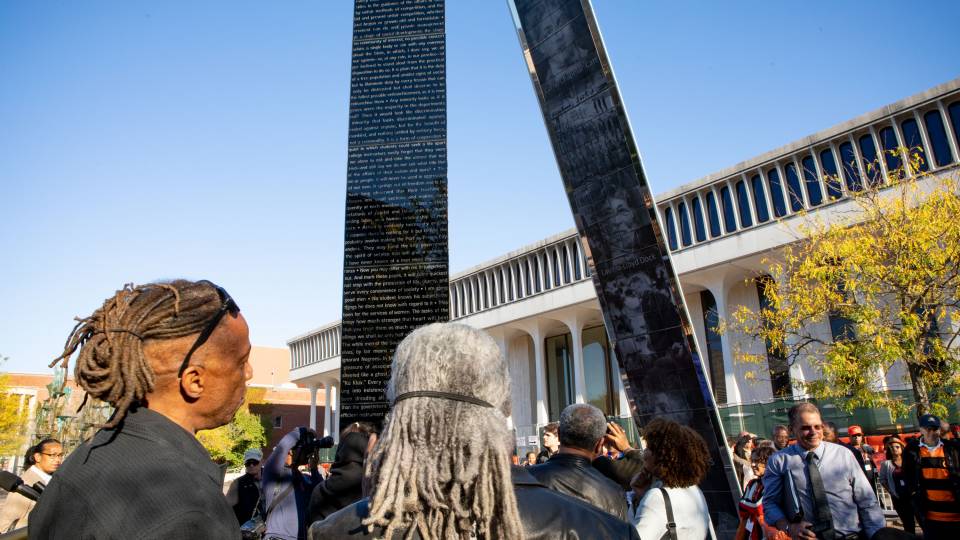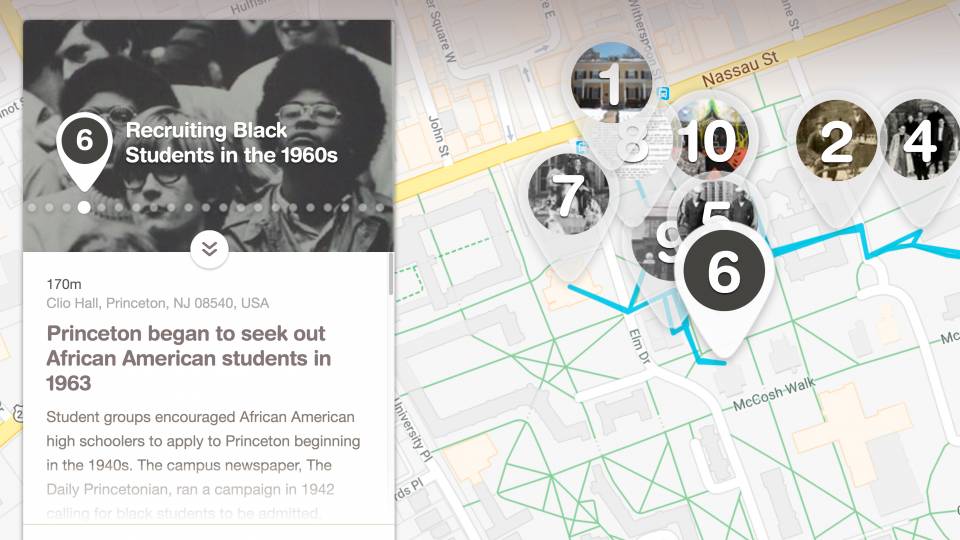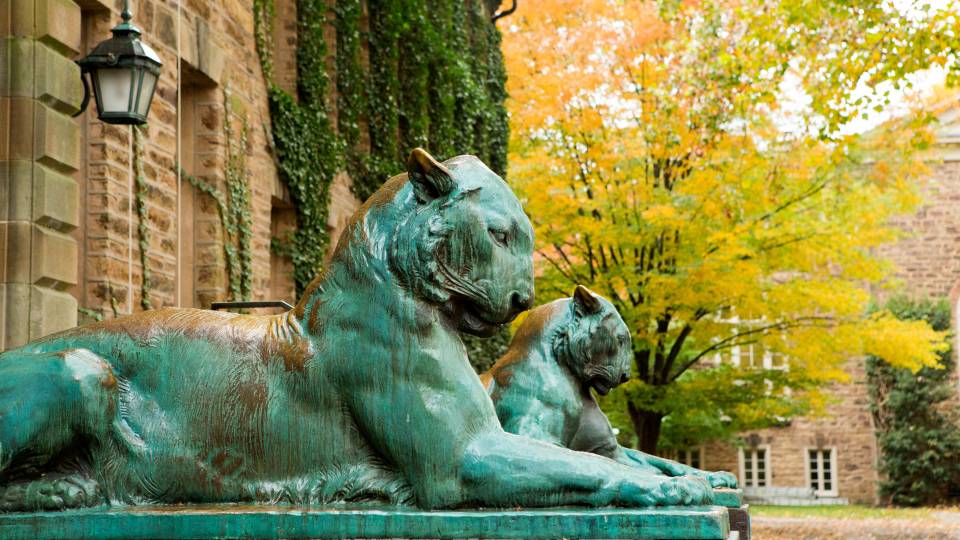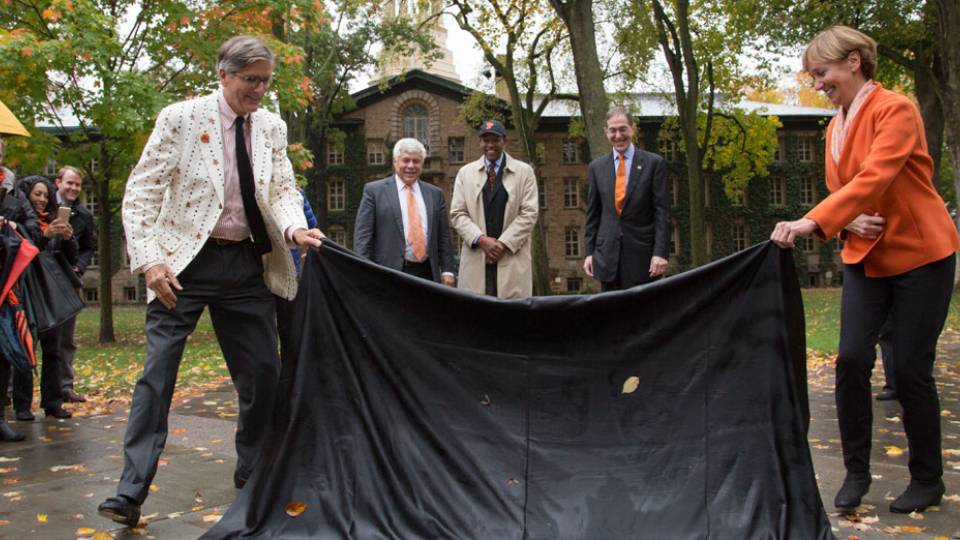The family of Carl Fields, Princeton’s first black academic administrator, celebrates the unveiling of Fields’ portrait, one of four new additions to the Princeton University portrait collection revealed to the public at a ceremony held Sept. 20 in Chancellor Green. The portraits highlight extraordinary individuals and the diversity of the Princeton community.
Four portraits that capture the broad diversity of Princeton University’s distinguished graduates and pioneers were unveiled Sept. 20 in a ceremony held at Chancellor Green.
Portraits of Denny Chin, Carl Fields, Robert Rivers and Alan Turing were officially revealed to the University community, and to their friends and family in attendance. The paintings will be added to the University’s permanent art collection and featured in prominent locations across campus.
“There’s no doubt that the extraordinary individuals selected have each made an enduring contribution to the life of this University, to the nation, and the world,” said University President Christopher L. Eisgruber. “The subjects of these paintings represent our history, our shared values, and our aspirations and goals for the years ahead. By including them in Princeton’s portrait collection, they help to more fully illuminate the rich story of this great University. They also will serve as a visible expression of Princeton as the welcoming community we are today, even as we continue to strive to become ever more inclusive and diverse in the years ahead.”

Earl Fields, left, reacts to the unveiling of his brother’s portrait together with University President Christopher L. Eisgruber. Carl Fields, namesake of Princeton’s Carl A. Fields Center for Equality and Cultural Understanding, died in 1998.
The University announced in 2018 it would commission eight new portraits to recognize individuals who, over the past 75 years, have been preeminent in a particular field, who have excelled in the nation’s service and the service of humanity, or have made a significant contribution to the culture of Princeton.
Renderings of Toni Morrison, the Robert F. Goheen Professor in the Humanities, Emeritus, and Nobel-winning author, and Sir W. Arthur Lewis, Nobel laureate in economic sciences and the University’s first black full professor, were commissioned in 2017. Theirs were the first portraits, outside of University presidents and deans of the Graduate School and the engineering school, that were added to Princeton’s portrait collection since the mid-19th century. Two years ago, Morrison also was honored with the naming of Morrison Hall, and Lewis with the naming of the main auditorium in Robertson Hall.
Four more portraits will be entered into the University’s collection in 2020: former U.S. Senator William Bradley, Class of 1965; Elaine Fuchs, Graduate School Class of 1977 and a world-renowned leader in cell biology and molecular genetics; Ruth Simmons, a distinguished Princeton administrator and former vice provost who now serves as president of Prairie View A&M University; and Supreme Court Justice Sonia Sotomayor, Class of 1976.

U.S. Circuit Judge Denny Chin, right, and artist Ying-He Liu pose with his portrait.
In introducing Eisgruber and delivering opening remarks, Deborah Prentice, University provost and the Alexander Stewart 1886 Professor of Psychology and Public Affairs, made note of the thousands of visitors who arrive on Princeton’s campus each year seeking to engage with its history.
“We value history, and given that, it’s somewhat surprising that we have not always been conscious of and intentional about how we construct our history, and in particular, who gets included in that history and who does not,” Prentice said. “The portrait collection is a case in point. … We’re here today to take one small step to remedying that.”
Chin and Rivers were in attendance with their families for the unveiling ceremony. Carl Fields died in 1998 at age 79; Alan Turing died in 1954 at age 41.
Chin, a United States Circuit Judge for the Second Circuit, shared that as a first-generation Chinese American and first in his family to attend college, he arrived at Princeton 48 years ago alone on a bus he had taken from the Port Authority in New York City carrying two suitcases.
“Who could imagine that one day we would be back here for a ceremony to unveil my portrait?” he said. “And that I would be honored as part of a group that includes, among others, a Supreme Court justice, a former United States senator and star for the New York Knicks, a Nobel prize-winning author and pioneering individuals like Alan Turing, Carl Fields and Dr. Rivers?”
Fields’ brother Earl, accompanied by more than a dozen family members, said many of his kin traveled across the country to share in honoring their relative and Princeton’s first African American administrator. “We are deeply, deeply indebted to Princeton University for work that was allowed after Carl was here,” he said, referring to the University’s continuation of Fields’ dedicated efforts to recruit and retain black students.
He noted alumna and former First Lady Michelle Obama’s mention of the Carl A. Fields Center for Equality and Cultural Understanding — then called the Third World Center — in her 2018 book, “Becoming,” and its impact on her Princeton experience.
“In her book, early in the book, she makes reference to her time at Princeton University and makes reference to the fact that it was because of the Carl Fields Center that she was able to deal with the issues that she had to, and to continue to proceed, and go through with graduation in the comforting atmosphere and environment that was there,” he said. This year commemorates the 10th anniversary of the Fields Center in its current location.

Artist Jordan Sokol of Jersey City, New Jersey, right, who painted the portrait of Alan Turing, a Princeton graduate alumnus widely recognized as the father of modern computer science, brought his wife, Amaya Gurpide, and son, Dylan Gurpide Sokol, to share in the occasion.
Turing’s portrait was introduced by Eisgruber and Jennifer Rexford, the Gordon Y.S. Wu Professor in Engineering, professor of computer science and chair of the Department of Computer Science.
“In the computer science department at Princeton, we owe a tremendous intellectual debt to Alan Turing for our historical strength in theoretical computer science, of course, but also research in artificial intelligence and machine learning, and even working at the intersection of computing with biology, a topic Turing pursued in the last few years of his short life,” she said. “And finally, in the applications of computing to the service of nations and of humanity.”
“For those of us in the LGBTQ community, Turing is an enduring icon, and the growing appreciation of his life and his great contributions to the world are a cause for hope and celebration,” she added.
The Bank of England's 50-pound note will bear Turing's image on currency scheduled to enter circulation by late 2021.

Robert Rivers, left, a retired professor of clinical surgery and associate dean for minority affairs at the University of Rochester School of Medicine and Dentistry who was among the first African American students admitted to Princeton, examines his portrait with Eisgruber.
Rivers — among the first black undergraduates admitted to the University, as well as one of the first black students from the town of Princeton — gave brief remarks after the unveiling of his portrait.
“I am deeply honored at having my portrait included in the Princeton University portrait collection,” he said. “I am very grateful for the concerted efforts of so many to make this moment possible for me. My portrait, with my story, is a part of Princeton University’s story, and I enjoy the changes that have taken place during my long Princeton journey.”
The roadway that enters campus from Nassau Street between Firestone Library and the buildings of the Andlinger Center for the Humanities will be named Rivers Way in his honor and dedicated on Oct. 3.
The University formed the Portraiture Nominations Committee (PNC) in fall 2017 to solicit and review suggestions for new University portraits. The PNC is part of the Campus Iconography Committee, which is overseeing a number of efforts to update and diversify campus art and iconography as recommended in the 2016 Report of the Trustee Committee on Woodrow Wilson's Legacy at Princeton.
Read more about the four new portrait subjects below. The Portraiture website has information about all 10 individuals to be recognized with portraits.

Portrait of Denny Chin, painted by Ying-He Liu
Denny Chin, Class of 1975
Artist: Ying-He Liu
Location: Outside Room 50, McCosh Hall
Denny Chin has been a federal judge since 1994. Now a United States Circuit Judge for the Second Circuit, Judge Chin has presided over many notable cases over the course of his career, including those involving Megan’s Law, the United Nations Oil for Food Program, the Million Youth March, the Google Books project, and the sentencing of Bernard Madoff. He also teaches legal writing at Fordham Law School, where he received his law degree in 1978.
Judge Chin’s long history of service to Princeton ranges from a term on the Board of Trustees (during which he chaired the Committee on Student Life, Health and Athletics) to a leadership role in the Asian American Alumni Association (A4P) to his tenure as staff writer and managing editor of The Daily Princetonian while a student. At the A4P’s “We Flourish” conference in 2015, he and his wife, Kathy Hirata Chin, also of the Class of 1975, along with alumni and student readers, presented “The Heart Mountain Draft Resisters,” one of a number of historical reenactments that he has written based on noteworthy trials and cases involving Asian Americans. He is the recipient of the University’s 2011 Woodrow Wilson Award. Born in Hong Kong, Judge Chin was the first Asian American appointed as a United States District Judge outside of California and Hawaii. He serves in the same New York courthouse where his grandfather took the U.S. oath of allegiance many years ago.
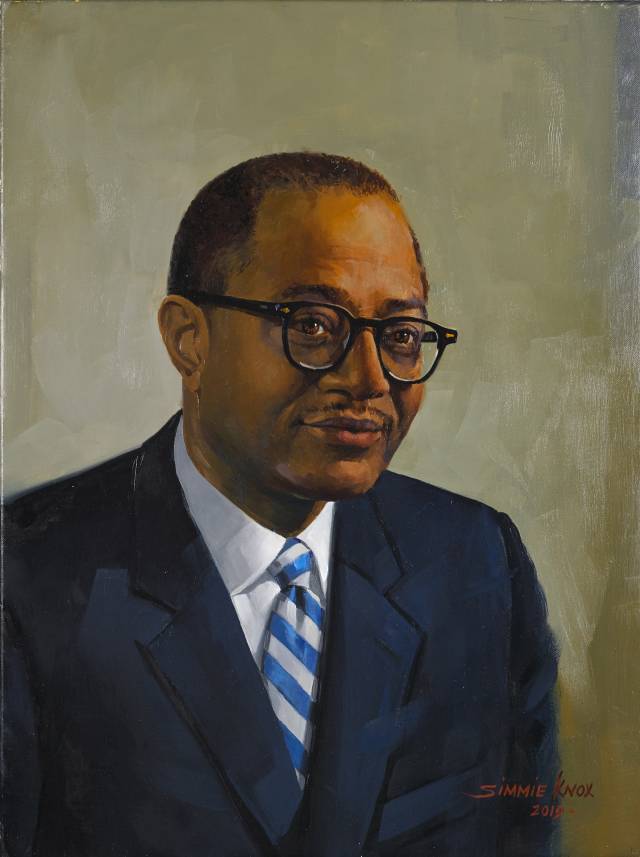
Portrait of Carl Fields, painted by Simmie Knox
Carl Fields
Artist: Simmie Knox
Location: Morrison Hall, south door
Carl Fields began his career at Princeton in 1964 as assistant director of student aid. He was the University’s first African American administrator at a time when there were only 12 black undergraduates. Fields introduced a surrogate family hosting program that paired black students with community members, helped develop the Association of Black Collegians and other student groups, and organized a noteworthy conference that addressed black students’ experiences at predominantly white universities. In 1968, when he was promoted to assistant dean of the college, he became the first African American dean at any Ivy League school.
Fields implemented policies and practices that increased enrollment and retention of students of color, and was instrumental in establishing the Third World Center, now known as the Carl A. Fields Center for Equality and Cultural Understanding, which was conceived as a gathering place for the University's minority students and a focal point for the activities of the University’s minority groups. By the time he left the University in 1971, to serve as planning officer at the University of Zambia and later founder of the African Technical Educational Consultant Service, more than 300 people of color were enrolled as undergraduates. He wrote, “I left with full confidence that blacks and other minority members had established themselves as a significant presence at Princeton.”

Portrait of Robert Rivers, painted by Sam Adoquei
Robert Rivers, Class of 1953
Artist: Sam Adoquei
Portrait location: University Health Services, McCosh Health Center
Robert Rivers, retired professor of clinical surgery and associate dean for minority affairs at the University of Rochester School of Medicine and Dentistry, was among the first African American students admitted to Princeton. In 1969 he was the first African American elected by the Board of Trustees to serve as a trustee. Four years later he was re-elected to a second term. He earned his M.D. from Harvard University in 1957, enjoyed a long career as a vascular surgeon and educator, saw three sons graduate from Princeton, and, returning to his roots, now lives with his wife, Ruth, in the same Princeton house where he grew up.
The citation for his honorary Doctor of Humanities degree from Princeton in 2016 noted that Dr. Rivers “is a true Princeton pioneer. His grandfather planted the first elms along Washington Road. His father worked at Tiger Inn and as a dormitory janitor; his mother cared for a professor’s family. … A distinguished surgeon and a mentor and role model for generations of students and alumni, he paved the way toward a University increasingly committed to diversity and inclusion, and he did it with dignity, grace, integrity and a lifelong devotion to this University’s highest values.”

Portrait of Alan Turing, painted by Jordan Sokol
Alan Turing, Graduate School Class of 1938
Artist: Jordan Sokol
Location: Lewis Library atrium
Alan Turing is widely recognized as the father of computer science and is an icon in the history of lesbian, gay, bisexual and transgender (LGBT) rights. He entered Princeton in 1936 following studies at King’s College, Cambridge, and just before the publication of his influential paper, “On Computable Numbers,” in which he envisioned abstract machines (now called Turing machines) that became the basis of modern computers. After earning his Ph.D. in mathematics from Princeton in 1938, Turing returned to his native England, where during World War II he was central to the successful effort to decode the German Enigma ciphers, a crucial development in the Allied victory.
Turing, an openly gay man when homosexual acts were still criminal acts in the United Kingdom, was convicted of “gross indecency” in 1952. In order to avoid prison, he had to agree to undergo a series of estrogen injections. He died two years later from what was believed to be suicide. In 2013, the British government granted Turing a posthumous pardon, following an apology for “the appalling way he was treated,” and now upholds an amnesty law informally known as the Alan Turing law.
A mobile audio tour on Princeton’s portraits collection will be added in the future.




